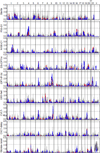Genetic assessment of additional endophenotypes from the Consortium on the Genetics of Schizophrenia Family Study
- PMID: 26597662
- PMCID: PMC4707095
- DOI: 10.1016/j.schres.2015.11.008
Genetic assessment of additional endophenotypes from the Consortium on the Genetics of Schizophrenia Family Study
Abstract
The Consortium on the Genetics of Schizophrenia Family Study (COGS-1) has previously reported our efforts to characterize the genetic architecture of 12 primary endophenotypes for schizophrenia. We now report the characterization of 13 additional measures derived from the same endophenotype test paradigms in the COGS-1 families. Nine of the measures were found to discriminate between schizophrenia patients and controls, were significantly heritable (31 to 62%), and were sufficiently independent of previously assessed endophenotypes, demonstrating utility as additional endophenotypes. Genotyping via a custom array of 1536 SNPs from 94 candidate genes identified associations for CTNNA2, ERBB4, GRID1, GRID2, GRIK3, GRIK4, GRIN2B, NOS1AP, NRG1, and RELN across multiple endophenotypes. An experiment-wide p value of 0.003 suggested that the associations across all SNPs and endophenotypes collectively exceeded chance. Linkage analyses performed using a genome-wide SNP array further identified significant or suggestive linkage for six of the candidate endophenotypes, with several genes of interest located beneath the linkage peaks (e.g., CSMD1, DISC1, DLGAP2, GRIK2, GRIN3A, and SLC6A3). While the partial convergence of the association and linkage likely reflects differences in density of gene coverage provided by the distinct genotyping platforms, it is also likely an indication of the differential contribution of rare and common variants for some genes and methodological differences in detection ability. Still, many of the genes implicated by COGS through endophenotypes have been identified by independent studies of common, rare, and de novo variation in schizophrenia, all converging on a functional genetic network related to glutamatergic neurotransmission that warrants further investigation.
Keywords: Association; Endophenotype; Genetics; Heritability; Linkage; Schizophrenia.
Copyright © 2015 Elsevier B.V. All rights reserved.
Conflict of interest statement
Drs. Braff, Calkins, Greenwood, RE Gur, RC Gur, Olincy, Radant, Seidman, Siever, Silverman, Stone, Sugar, DW Tsuang, MT Tsuang, and Turetsky report no financial relationships with commercial interests. Dr. Freedman has a patent through the Department of Veterans Affairs on DNA sequences in CHRNA7. Dr. Green has been a consultant to AbbVie, Biogen, DSP, EnVivo/Forum, and Roche; he is on the scientific advisory board of Mnemosyne; and he has received research funds from Amgen. Dr. Lazzeroni is an inventor on a patent application filed by Stanford University on genetic polymorphisms associated with depression. Dr. Light has served as a consultant for Astellas, Forum, and Neuroverse. Dr. Nuechterlein has received unrelated research support from Janssen Scientific Affairs, Genentech, and Brain Plasticity, Inc., and has consulted to Genentech, Otsuka, Janssen, and Brain Plasticity, Inc. Dr. Swerdlow has been a consultant for Genco Sciences, Ltd.
Figures



References
-
- Abecasis GR, Cherny SS, Cookson WO, Cardon LR. Merlin--rapid analysis of dense genetic maps using sparse gene flow trees. Nat Genet. 2002;30(1):97–101. - PubMed
-
- Almasy L, Dyer TD, Blangero J. Bivariate quantitative trait linkage analysis: pleiotropy versus co-incident linkages. Genet Epidemiol. 1997;14(6):953–958. - PubMed
-
- American Psychiatric Association. Diagnostic and Statistical Manual of Mental Disorders 4-Text Revision edition. Washington DC: 2000.
-
- Aoki-Suzuki M, Yamada K, Meerabux J, Iwayama-Shigeno Y, Ohba H, Iwamoto K, Takao H, Toyota T, Suto Y, Nakatani N, Dean B, Nishimura S, Seki K, Kato T, Itohara S, Nishikawa T, Yoshikawa T. A family-based association study and gene expression analyses of netrin-G1 and -G2 genes in schizophrenia. Biol Psychiatry. 2005;57(4):382–393. - PubMed
Publication types
MeSH terms
Grants and funding
- K01-MH087889/MH/NIMH NIH HHS/United States
- R01 MH086135/MH/NIMH NIH HHS/United States
- R01-MH065571/MH/NIMH NIH HHS/United States
- R01 MH065558/MH/NIMH NIH HHS/United States
- R01-MH065588/MH/NIMH NIH HHS/United States
- R01 MH065562/MH/NIMH NIH HHS/United States
- R01-MH065578/MH/NIMH NIH HHS/United States
- R01-MH065554/MH/NIMH NIH HHS/United States
- R01-MH065562/MH/NIMH NIH HHS/United States
- R01 MH065707/MH/NIMH NIH HHS/United States
- K01 MH087889/MH/NIMH NIH HHS/United States
- R01 MH065571/MH/NIMH NIH HHS/United States
- R01-MH065707/MH/NIMH NIH HHS/United States
- HHSN268200782096C/HG/NHGRI NIH HHS/United States
- R01MH86135/MH/NIMH NIH HHS/United States
- R01 MH065554/MH/NIMH NIH HHS/United States
- R01 MH065578/MH/NIMH NIH HHS/United States
- R01-MH065558/MH/NIMH NIH HHS/United States
- R01 MH065588/MH/NIMH NIH HHS/United States
LinkOut - more resources
Full Text Sources
Other Literature Sources
Medical
Miscellaneous

